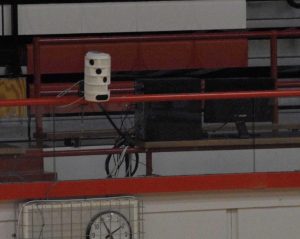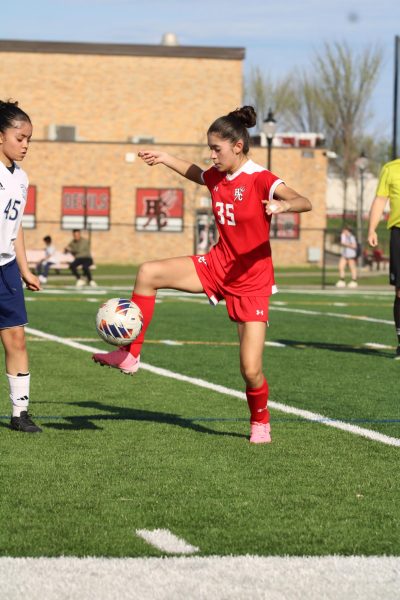New cameras enhance sports broadcasting
The school invested in new, state-of-the-art cameras to record games and practices, as pictured on Dickinson Field’s scorebox. These recordings will help teams to better assess their performances and allow fans to receive better broadcasts.
During the summer, new high definition cameras were installed in the gym and the football field to provide an easier, more efficient way to broadcast games. The new cameras are high quality and automatic, with sensors that allow them to track the play and move along with it.
The cameras allow for a smoother viewing experience and will better follow the action. The stream will now be hardwired rather than be connected by Wifi which will result in better quality videos along with less lagging and screen freezes.

A set of the cylinder-shaped cameras can also be found just above the women’s locker room entrance in the main gym.
The cameras will also allow the school to broadcast more games than ever before because there is no longer a need for a filmer. The filmers were often students from the Broadcasting Club or in some cases paid workers.
“The hardest thing was getting enough kids to film [the games]…but with these new cameras we don’t need kids to run it. We can actually just program in a time to start the cameras and they will automatically turn on to film the event,” said Mr. Robert Russo, Broadcasting Club sponsor.
Each camera is equipped with four lenses, so that as the camera follows the ball it can switch between the lenses to get the best angle. Before, the students filming would manually move the cameras, which would often result in them not being able to catch every play of the game.
The cameras are also linked to the scoreboard so the time and the score will show up automatically for online viewers. Games are broadcasted live and archived for those who want to watch later on. Depending on the game, live views can go up to a couple hundred people.
“[Athletes’] families are able to view the game if they can’t make it or are out of town, so people can watch the games whenever they have time,” said Mr. Dan Jones, Athletics Director.
Viewers can access the broadcasted games on the NFHS website. To be able to view games, a monthly ($10), semi-annual ($40) , or annual ($60) fee is required. The subscription allows viewers to not only watch Central’s games but also games broadcasted by high schools across the country.
The cameras cost the school a total of $10,000, and the amount was split between the Broadcasting Club, who raised money by selling graduation and other sports DVDs, and the Athletics Department.
“I believe this is one of our biggest investments, and this is significant upgrade the club has received. Now we can focus on announcing the game, rather than worrying about if our tech will not cooperate,” said Jacob Nunez, senior member of the Broadcasting Club.
The school decided to invest in these cameras to ease the process of broadcasting the games and provide a better viewing experience for watchers. It also will help the school save money on having to hire workers to film games when students are not available.
“We did it because there was a 50 percent sale, so we saved money on them, and because we were going to be able to livestream more events and do it much easier,” Mr. Jones said.
For now, the school isn’t planning to add these new cameras to areas like the pool or soccer field because the cost is too high. The cameras are still being set up, but the Broadcasting Club hopes Friday’s football game will be the first streamed game using the new camera.

Hajera Naveed is a Senior Writer and Section Editor for Devils' Advocate. Her hobbies include writing, volunteering, painting, and running. When she isn't...

Nick Seda, a senior at Hinsdale Central, is a section editor for multimedia on Devils' Advocate, whom enjoys traveling the world, taking pictures...










